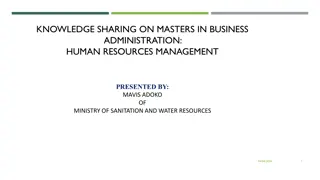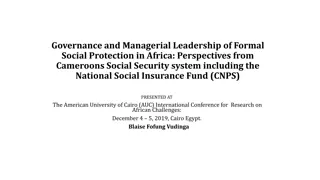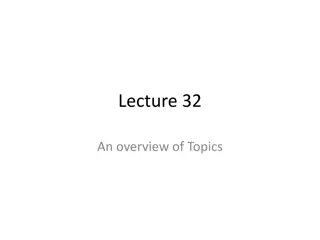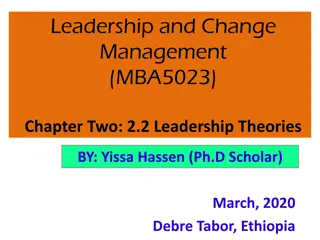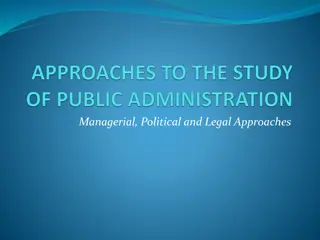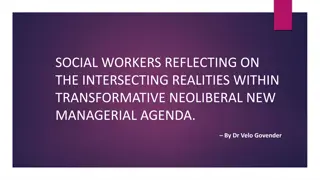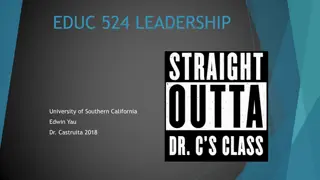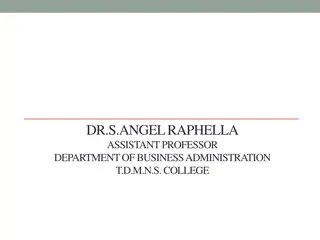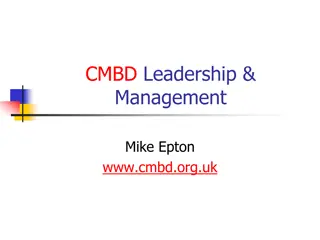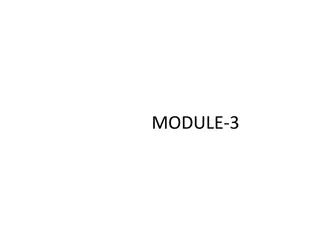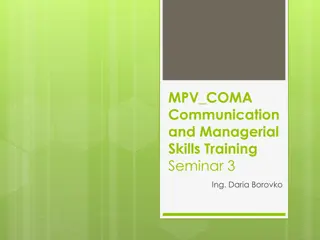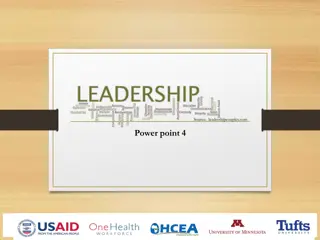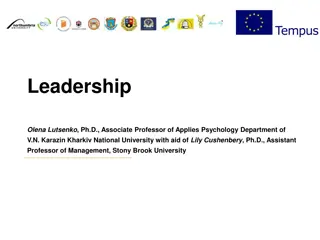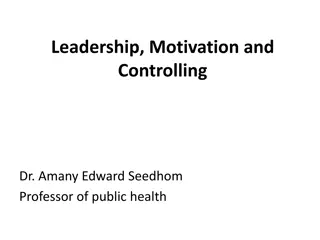
Understanding the Complexities of Leadership: Definitions and Influence Processes
Delve into the intricacies of leadership by exploring definitions, the difference between leadership and management, measuring leadership effectiveness, indicators of effective leadership, and the aspects of leadership studied over the past 50 years. Examine leadership in individual, group, and organizational contexts, and understand the specialized role versus shared influence process debate.
Download Presentation

Please find below an Image/Link to download the presentation.
The content on the website is provided AS IS for your information and personal use only. It may not be sold, licensed, or shared on other websites without obtaining consent from the author. If you encounter any issues during the download, it is possible that the publisher has removed the file from their server.
You are allowed to download the files provided on this website for personal or commercial use, subject to the condition that they are used lawfully. All files are the property of their respective owners.
The content on the website is provided AS IS for your information and personal use only. It may not be sold, licensed, or shared on other websites without obtaining consent from the author.
E N D
Presentation Transcript
Introduction: Introduction: The Nature of Leadership The Nature of Leadership Cut Sarah, M. Psi., Psikolog
Learning Objectives Memahami definisi kepemimpinan Memahami perbedaan antara kepemimpinan dan manajemen; Leader VS Manager Memahami kompleksitas mengukur efektivitas kepemimpinan Memahami indikator-indikator efektivitas kepemimpinan Memahami aspek-aspek kepemimpinan yang diteliti selama 50 tahun terakhir Memahami kepemimpinan dalam konteks individual, kelompok, dan proses organisasi.
Definisi Leadership (Kepemimpinan) Sering mixed up dengan istilah-istilah power, authorithy, management, administration, control, & supervision.
Kepemimpinan meliputi proses menggunakan pengaruhnya terhadap orang lain untuk membimbing, mengatur, dan memfasilitasi aktivitas dan hubungan-hubungan dalam kelompok atau organisasi. Kepemimpinan adalah fenomena penting bagi efektivitas suatu organisasi.
Specialized Role or Shared Influence Process? Pemimpin as specialized role dianggap bahwa setiap anggota dari suatu kelompok pasti memiliki perannya masing-masing, termasuk peran pemimpin yang memiliki tanggung jawab dan fungsi-fungsi yang tidak bisa dibagi secara luas tanpa mengorbankan efektivitas dari kelompok Leader-Followers Pemimpin as shared influence process dianggap sebagai proses yang terjadi secara alami dalam sistem sosial yang dibagi bersama antar anggotanya. Definisi yang lebih sesuai untuk mempejari konstruk kepemimpinan
Types of Influence Process use rewards & punishments to manipulate/ coerce followers Enthusiastic commitment by followers Indifferent compliance or reluctant obediance Unethical use of power
Direct VS Indirect Leadership Direct leadership meliputi usaha mempengaruhi bawahannya ketika berinteraksi dengan mereka atau menggunakan media komunikasi untuk mengirimkan pesan pada mereka. Contoh: mengirim memo, email, menyelenggarakan meeting, dll. Indirect leadership menunjukkan usaha mempengaruhi orang-orang di level bawah dalam organisasi yang tidak berinteraksi secara langsung dengan pemimpin. Contoh: CEO menampilkan diri sebagai contoh yang baik dalam menegakkan kode etik dan bersikap supportif dapat mempengaruhi level bawah organisasi.
Leadership vs Management a person can be a leader without being a manager (e.g., an informal leader), and a person can be a manager without leading. Indeed, some people with the job title manager do not have any subordinates (e.g., a manager of financial accounts). Managers are concerned about how things get done, and they try to get people to perform better. Leaders are concerned with what things mean to people, and they try to get people to agree about the most important things to be done. Bennis and Nanus (1985, p. 21) proposed that managers are people who do things right, and leaders are people who do the right thing. Kotter (1990) proposed that managing seeks to produce predictability and order, whereas leading seeks to produce organizational change. Both roles are necessary, but problems can occur if an appropriate balance is not maintained. Too much emphasis on the managing role can discourage risk taking and create a bureaucracy without a clear purpose. Too much emphasis on the leadership role can disrupt order and create change that is impractical depends in part on the situation.
Conclusion from definition of leadership (Yukl, 2010): Leadership is the process of influencing others to understand and agree about what needs to be done and how to do it, and the process of facilitating individual and collective efforts to accomplish shared objectives.
Indikator Efektivitas Kepemimpinan (1) Sejauh mana kinerja tim dalam unit organisasi didorong dan pencapaian tujuan difasilitasi. Sales Net profits Profits margin Market share ROI Productivity, etc Objective Measures of Performance Ratings obtained from the leader s superior, peers, or subirdinated Subjective Measures of Performance
Indikator Efektivitas Kepemimpinan (2) Sikap & persepsi follower terhadap leader. Dapat diukur dengan kuesioner atau wawancara. (3) Efektivitas pemimpin juga dapat diukur berdasarkan kontribusinya terhadap kualitas proses kelompok yang dipersepsikan oleh pihak luar/ observer. (Does the leader enhance group cohesiveness, member cooperation, member commitment, and member confidence that the group can achieve its objectives? Does the leader enhance problem solving and decision making by the group, and help to resolve disagreements and conflicts in a constructive way? Does the leader contribute to the efficiency of role specialization, the organization of activities, the accumulation of resources, and the readiness of the group to deal with change and crises?) (4) Sejauh mana orang tersebut memiliki karir yang sukses sebagai pemimpin. (Is the person promoted rapidly to positions of higher authority? Does the person serve a full term in a leadership position, or is he or she removed or forced to resign? For elected positions in organizations, is a leader who seeks reelection successful?)
Overview of Major Research Approaches 3 tipe variabel yang relevan untuk memahami efektivitas kepemimpinan: Karakteristik LEADER KARAKTERISTIK FOLLOWERS KARAKTERISTIK SITUATION Traits (motives, personality, values) Confidence & optimism Skills & expertise Behavior Integrity Influence tactics Attribution about followers Traits (needs, values, self concept) Confidence & optimism Skills & expertise Attribution about leader Trust in leader Task commitment & effort Satisfaction with job & leader Type of organizational unit Size of unit Position, power, & authority of leader Task structure & complexity Task independence Organizational culture Environmental uncertainty External dependencies National cultural value
1. THE TRAIT APPROACH 5. THE INTEGRATIVE APPROACH 2. THE BEHAVIOR APPROACH Theories & Empirical Research about Leadership 4. THE SITUATIONAL APPROAC H 3. THE POWER- INFLUENCE APPROACH
Levels of Conceptualization for Leadership Process ORGANIZATION GROUP DYADIC INDIVIDUAL
Research Questions at Different Levels of Conceptualization
Other Bases for Comparing Leadership Theories Leader-Centered vs Follower- Centered Theory Descriptive vs Prescriptive Theory Universal vs Contingency Theory
GROUP DISCUSSION 1. What are some similarities and differences in the way leadership has been defined? Does it really matter how you define leadership? Explain and defend the position you take on this question. What are the arguments for and against making a distinction between leaders and managers? Why is it so difficult to measure leadership effectiveness? What criteria have been used to evaluate leadership effectiveness? Are some criteria more useful than others? What are the trait, behavior, and power-influence approaches? What unique insights does each approach provide about effective leadership? Why does it matter whether leadership is described as an intra- individual, dyadic, group, or organizational process? Which level of analysis is emphasized in most leadership theories and research? Compare universal and contingency theories. Is it possible to have a theory with both universal and contingent aspects? 2. 3. 4. 5. 6. 7. 8.
Tugas Utama Psikologi Kepemimpinan Tugas Individual: Review Jurnal terkait Psikologi kepemimpinan. Tugas Kelompok: -Diskusi mingguan -Presentasi Studi Kasus by Chapter -Analisis Tokoh Deadline: (Tugas Individual pengumpulan bebas maksimal 2 minggu sebelum UAS) (Tugas Kelompok: Presentasi studi kasus (sesuai pembagian kelompok); Analisis Tokoh (Presentasi di dua pertemuan akhir sebelum UAS). NB: Tidak ada perbaikan nilai, nilai setelah UAS fixed tidak dapat diganggu gugat. Tugas tambahan (jika merasa perlu) Review Buku apapun dikaitkan dengan Psikologi Kepemimpinan.
KELOMPOK BAGIAN PEMBAHASAN (SUMBER, YUKL 2010) 1 Chapter 2 (The Nature of Managerial Work) 2 Chapter 3 (Perspective on Effective Leadership Behavior) 3 Chapter 4 (Participative Leadership, Delegation, & Empowerment) 4 Chapter 5 (Dyadic Relations, Attributions, & Followership) 5 Chapter 6 (Power & Influence) 6 Chapter 7 (Managerial Traits & Skills) 7 Chapter 8 (Early Contingency Theories of Effective Leadership) 8 Chapter 9 (Charismatic & Transformasional Leadership) 9 Chapter 10 (Leading Change in Organizations) 10 Chapter 11 (Leadership in Teams & Decision Groups)

